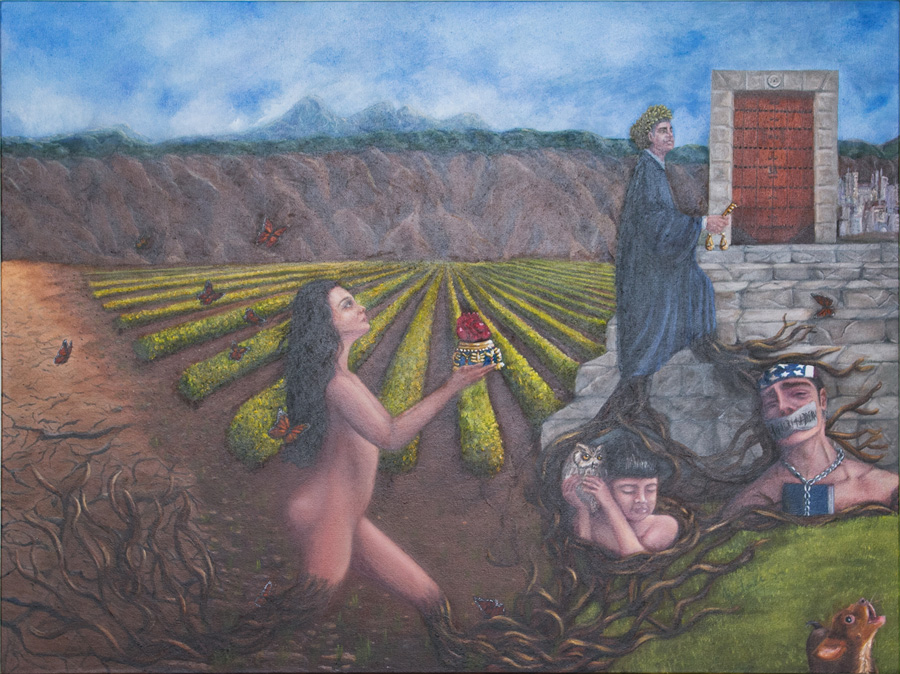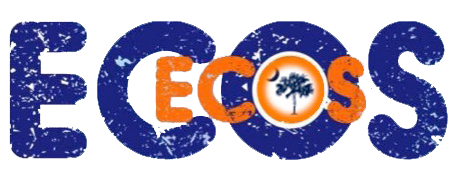
Felipa Sows Better Human Beings.
Oil on canvas
30 x 40”
Biography
A native of Caracas, Venezuela, Ninotchka Santamaría studied at the school of the arts of the Universidad Central de Venezuela where she obtained a BA (1999) in Cinematography. During this time, she served as a Cultural Promoter at the Department of Culture for the Mayor of Baruta in Caracas and was a member of the Board of the Ateneo of Baruta. In 2001, she moved with her family to Syracuse, New York, and since 2004 she has lived in Spartanburg, South Carolina. She resumed her artistic career in 2007, studying drawing, oil painting, sculpture and stained glass at the Chapman Cultural Center in Spartanburg, while taking classes with private tutors. She has created props for several productions of the Ballet Spartanburg. Ninotchka continues experimenting and looking for sources of personal nourishment to enhance her artistic work. She aspires to achieve a personal style that demonstrates emotion and reveals her perception of the world.
Creative Interpretation
The work has a rectangular format, which serves as a panoramic window. The vivid and vibrant colors denote positivity and hope for Felipa as they have done for so many. I present Felipa in the foreground, as a single mother, a fighter, with little formal education who leaves a barren land. She flees looking for a better future for her children. They accompany her on the dangerous journey, playful, without fear, like monarch butterflies. Naked, with nothing to hide, letting go of what binds her, Felipa moves forward at a steady pace. She carries a small jewelry box of great value. In it she carries her life, her children and her hopes. Her hands are worn with years of hard work tending to the bountiful earth. On the lid of the box, there is a heart, an offering that she will give to the new land. In the background, one of her children is depicted in three phases of life. Felipa looks at him proudly, but with a touch of melancholy. They are deeply connected. Felipa supports him in his goals to become a good human being and a working professional. From the nest of her maternal love emerges the figure of an owl, a symbol of wisdom. Then, a young man he climbs steps of the rocky staircase, his dream is hindered by reality. He naively believes he is part of the new land. He perseveres in the face of great resistance and finally succeeds on his merits. In his hands, he carries the key of justice that will help him to open the doors of freedom. This is an allusion to the door of Simón Bolívar’s home in Caracas, Venezuela. In the first plane, we see a modern city to which the young man seeks access. Likewise, there are mountains that denote the topography of one of the areas heavily traveled by immigrants. There is also a crop planted by people like Felipa. In a close-up on the far right, a small dog barks as Felipa tells her story. He is not aggressive, but he demands attention. In the distant mountains, there is the silhouette of the artist, the creator and omniscient observer.
Felipa siembra mejores seres humanos.
Óleo sobre lienzo
30 x 40”
Biografía
Ninotchka Santamaría nació en Caracas, Venezuela. Estudió en la Universidad Central de Venezuela (UCV) en la Escuela de Artes, obteniendo una Licenciatura en Cinematografía en 1999. Durante ese tiempo, se desempeñó como promotora cultural en el Departamento de Cultura de la Alcaldía del Municipio de Baruta en Caracas, Venezuela y fue miembro de la junta directiva del Ateneo de Baruta. En 2001, se mudó con su familia a Syracuse, Nueva York y desde 2004, vive en Spartanburg, Carolina del Sur. En 2007 retomó su contacto con lo artístico. Estudió técnicas de dibujo, pintura al óleo, escultura y vitrales en Chapman Cultural Center de Spartanburg y bajo la guía de profesores particulares. Ha creado accesorios para varias producciones del Spartanburg Ballet. Santamaría continúa experimentando y buscando fuentes de nutrición personal para mejorar sus producciones artísticas. Busca lograr un estilo personal que muestre emociones y proyecte su punto de vista del mundo que la rodea.
Interpretación creativa
La obra tiene un formato rectangular a modo de ventana panorámica. Los colores vivos y vibrantes utilizados denotan positividad y esperanza para Felipa y su entorno que representan la historia de muchos. A Felipa la presento en primer plano, como una madre soltera, luchadora, con poca instrucción escolar que abandona una tierra infértil. Ella huye buscando un mejor porvenir para sus hijos, quienes la acompañan en su peligrosa jornada, juguetones, sin miedos, como mariposas monarcas. Desnuda, sin nada que ocultar, soltándose de lo que la ata, a paso firme, lleva un pequeño cofre de gran valor en el que van su vida, sus hijos y las mejores intenciones que tiene para ofrecer. Lo cargan sus manos curtidas de trabajo duro pero hábil, expertas en arrullar la tierra y obtener de ella sus frutos como respuesta a sus bondades en agradecimiento. En la tapa del joyero se observa un corazón, que igualmente, a modo de ofrenda entrega a la nueva tierra que la recibe. En segundo plano, se observa a uno de sus hijos en tres fases de vida. Ella no deja de verlo orgullosamente con cierto dejo de melancolía. Fuertemente entrelazados y desde pequeño, Felipa lo apoya en su anhelo de convertirse en buen ser humano y profesional, mientras que desde su nido materno el acaricia la posibilidad en la figura de un búho, símbolo de sabiduría. Ya como joven subiendo peldaños de la accidentada escalera rocosa, su sueño se ve truncado por su verdad. A pesar de sentir y creer ser parte la patria que siempre vio como suya, está ajeno a ella. Todo su esfuerzo y conocimientos pesan en su cuello empujándolo hacia abajo. Es difícil zafarse, pero él continúa con la lucha a pesar de no tener voz. Finalmente, es tomado en cuenta por su exhaustiva lucha y honor al mérito propio. Logra vestir la anhelada toga y es coronado con laureles. Entre sus manos lleva la llave de la justicia que le ayudara a abrir la puerta de la libertad, esta es una alusión de la puerta de la Casa Natal del Libertador Simón Bolívar, en Caracas, Venezuela. En tercer plano, se ve una ciudad moderna a la que el joven busca tener acceso. Igualmente, se observan montañas que denotan la topografía de una de las zonas altamente transitadas por inmigrantes. También se aprecia un sembradío trabajado por gente como Felipa. En un primer plano en la extrema derecha, un pequeño perro no deja de ladrar mientras ella cuenta la historia. No es agresivo, reclama atención y la obtuvo. Finalmente, en un tercer plano, en la montaña más lejana, se observa la silueta del rostro del artista, que dio vida a la obra como observador omnisciente.
